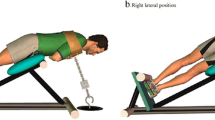Abstract
This prospective longitudinal clinical study evaluates the prognostic value of age in the therapy outcome of patients with chronic low back pain treated with a multidisciplinary therapy. Four hundred five patients with chronic low back pain for 3 months or longer and a corresponding sick leave for longer than 6 weeks underwent a 3-week standardized multidisciplinary therapy. Patients were assigned into three groups of age with comparable baseline values at T0. At the 6-month follow-up (T1) five different therapy outcomes were analysed and compared in the three groups: back-to-work status, generic health status (SF36), pain intensity, functional capacity, and satisfaction with the therapy. All three treatment groups improved significantly in all outcome criteria between T0 and T1 except of functional capacity, which did not improve in the older patients. In the total group, the back-to-work rate was 61.7%. At the final follow-up, there were significantly better results in terms of functional capacity and pain level in younger patients, whereas back-to-work rate and satisfaction with therapy did not show a significant difference between the groups analysed. According to the results of this study, older patients with chronic low back pain also derive significant benefit from a multidisciplinary treatment strategy, although in some outcome criteria results were inferior to those obtained in younger patients.
Similar content being viewed by others
References
Badley EM, Rasooly I, Webster GK (1994) Relative importance of musculoskeletal disorders as a cause of chronic health problems, disability, and health care utilization: findings from the 1990 Ontario health survey. J Rheumatol 21:505–514
Van Tulder MW, Koes BW (2002) Chronic low back pain and sciatica. Clin Evid 7:1032–1048
Hicks GS, Duddleston DN, Russell LD, Holman HE, Shepherd JM, Brown CA (2002) Low back pain. Am J Med Sci 324:207–211
Report of the Quebec task Force on Spinal Disorders (1987) Scientific approach to the assessment and management of activity-related spinal disorders. Spine 12(Suppl 7):1–16
Guzman J, Esmail R, Karjalainen K, Malmivaara A, Irvin E, Bombardier C (2001) Multidisciplinary rehabilitation for chronic low back pain: systematic review. BMJ 322:1511–1516
Van Tulder M, Koes B, Bombardier C (2002) Low back pain. Best Pract Res Clin Rheumatol 16:761–775
Bendix AF, Bendix T, Haestrup C (1998) Can it be predicted which patients with chronic low back pain should be offered tertiary rehabilitation in a functional restoration program? A search for demographic, socieconomic, and physical predictors. Spine 23:1775–1783
Cairns D, Mooney V, Crane P (1984) Spinal pain rehabilitation: inpatient and outpatient treatment results and development of predictors for outcome. Spine 9:91–95
Fredrickson BE, Trief PM, Van Beveren P, Yuan HA, Baum G (1988) Rehabilitation of the patient with chronic back pain, a search for outcome predictors. Spine 13:351–353
Gallagher RM, Rauh W, Haugh LD et al (1989) Determinants of return-to-work among low back pain patients. Pain 39:56–67
Guck TP, Meilman PW, Skultety FM, Dowd ET (1986) Prediction of long-term outcome of multidisciplinary pain treatment. Arch Phys Med Rehabil 67:293–296
Holmström EB, Lindell J, Moritz U (1992) Low back and neck/shoulder pain in construction workers: occupational workload and psychosocial risk factors. Spine 17:663–671
Eklund M (1992) Chronic pain and vocational rehabilitation: a multifactorial analysis of symptoms, signs, and psycho-socio-demographics. J Occup Rehabil 2:53–66
Haldorsen EMH, Kronholm K, Skouen JS, Ursin H (1998) Predictors for outcome of a multimodal cognitive behavioural treatment program for low back pain patients—a 12-month follow-up study. Eur J Pain 2:293–307
Hildebrandt J, Pfingsten M, Saur P, Jansen J (1997) Prediction of success from a multidisciplinary treatment program for chronic low back pain. Spine 22:990–1001
Pfingsten M, Hildebrandt J, Leibing E, Franz C, Saur P (1997) Effectiveness of a multidisciplinary treatment program for chronic low-back pain. Pain 73:77–85
Polatin PB, Gatchel RJ, Barnes D, Mayer H, Arens C, Mayer T (1989) A psycho-socio-medical prediction model of response to treatment by chronically disabled workers with low back pain. Spine 14:956–961
Sandström J, Esbjornsson E (1986) Return to work after rehabilitation. Scand J Rehab Med 18:29–33
Sheikh K (1987) Occupational injury, chronic low back pain and return to work. Public Health 101:417–425
Vendrig AA (1999) Prognostic factors and treatment-related changes associated with return to work in the multimodal treatment of chronic back pain. J Behav Med 22:217–232
Bombardier C (2000) Outcome assessments in the evaluation of treatment of spinal disorders: summary and general recommendations. Spine 25:3100–3103
Kellgren J, Lawrence J (1957) Radiological assessment of osteoarthritis. Ann Rheum Dis 16:494–502
Ware JE, Sherbourne CD (1992) The MOS 36-item short form health survey (SF-36). Med Care 30:383–473
Roland M, Morris R (1983) A study of the natural history of back pain: part I. Development of a reliable and sensitive measure of disability in low back pain. Spine 8:141–144
Kohlmann T, Raspe HH (1996) Der Funktionsfragebogen Hannover zur alltagsnahen Diagnostik der Funktionsbeeinträchtigung durch Rückenschmerzen (FFbH-R). Rehabilitation 35:1–8
Main CJ (1983) The modified somatic perception questionnaire (MSPQ). J Psychosom Res 27(6):503–514
Radloff LS (1977) The CES-D scale: a self -report depression scale for research in the general population. Appl Psychol Meas 3:385–401
Schonstein E, Kenny D, Keating J, Koes B, Herbert RD (2003) Physical conditioning programs for workers with back and neck pain: a Cochrane systematic review. Spine 28:E391–E395
Van der Giezen AM, Bouter LM, Nijhuis FJN (2000) Prediction of return-to-work of low back pain patients sicklisted for 3–4 months. Pain 87:285–294
Karjalainen K, Malmivaara A, Mutanen P, Pohjolainen T, Roine R, Hurri H (2003) Outcome determinants of subacute low back pain. Spine 28:2634–2640
Fishbain DA, Rosomoff HL, Goldberg M et al (1993) The prediction of return to the workplace after multidisciplinary pain center treatment. Clin J Pain 9:3–15
Author information
Authors and Affiliations
Corresponding author
Rights and permissions
About this article
Cite this article
Buchner, M., Neubauer, E., Zahlten-Hinguranage, A. et al. Age as a predicting factor in the therapy outcome of multidisciplinary treatment of patients with chronic low back pain—a prospective longitudinal clinical study in 405 patients. Clin Rheumatol 26, 385–392 (2007). https://doi.org/10.1007/s10067-006-0368-1
Received:
Revised:
Accepted:
Published:
Issue Date:
DOI: https://doi.org/10.1007/s10067-006-0368-1




